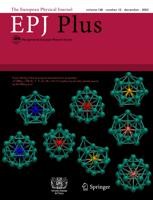Understanding the mechanism that gives light a ‘little extra push’
The use of light to move matter has a wide range of technological applications and could one day even power spaceflight. New research suggests a method to better understand this subtle phenomenon.
New York | Heidelberg, 7 May 2021
 We are all familiar with the sight of a white pool ball striking a red and smoothly transferring its momentum. What is less familiar is that light can also transfer momentum and is even able to give objects a tiny push. A new paper published in EPJ Plus suggests a way to examine the mechanism behind light’s subtle momentum transfer — the Poynting vector. The paper is the work of Manuel Marqués of IFIMAC-The Condensed Matter Physics Center, and the Nicolás Cabrera Institute (INC), Universidad Autónoma de Madrid, Spain, and Shulamit Edelstein and Pedro Serena from the Spanish National Research Council (CSIC).
We are all familiar with the sight of a white pool ball striking a red and smoothly transferring its momentum. What is less familiar is that light can also transfer momentum and is even able to give objects a tiny push. A new paper published in EPJ Plus suggests a way to examine the mechanism behind light’s subtle momentum transfer — the Poynting vector. The paper is the work of Manuel Marqués of IFIMAC-The Condensed Matter Physics Center, and the Nicolás Cabrera Institute (INC), Universidad Autónoma de Madrid, Spain, and Shulamit Edelstein and Pedro Serena from the Spanish National Research Council (CSIC).
“The momentum of light depends not on the mass or the speed but on something called the Poynting vector,” says Marqués. “This Poynting vector is linked to the light’s intensity so, we could say, that the larger the intensity the larger the Poynting vector.”
Marques explains this further with a familiar analogy, describing a game of pool, but replacing the cue with a laser beam and the pool balls with the simplest and smallest non-charged object —a single induced dipole. “Following the above reasoning,” the researcher adds. “The push on this ‘little ball’ is going to be proportional to the Poynting vector.”
This is the case for linearly-polarised light, but in the case of non-linearly polarised light current theories suggest there should be another contribution coming from a ‘virtual momentum’ called Belinfante momentum.
Investigating this extra contribution thus far has been extremely challenging, but Marqués and his co-authors suggest that this contribution’s influence should present itself in the scattering force felt by the dipole.
“We proposed a kind of rugby scrum competition, but instead of two teams, we used two lights, same colour or frequency, the same intensity and Poynting vector but one with an electric field non-linearly polarised and the other one with a magnetic field non-linearly polarised,” Marqués says. “The first one is pushing the particle to the right and the second one is pushing to the left. Without the existence of the Belinfante momentum, we should expect an even competition, no winner.”
Marqués adds that if this virtual Belinfante momentum is not so virtual after all the final winner is going to depend on the electric or magnetic nature of the dipole which, in turn, depends on the colour of the light used.
The team’s paper is presented as part of the Topical Collection ‘Focus Point on Light Pressure across All Scales’, edited by A. Macchi and O. M. Maragò.
The next step for the team is the development of an experimental set-up to test this theory. And the technological benefits from a better understanding of the manipulation of matter with light are clear.
“Radiation pressure has already a large field of applications ranging from microscopic optical tweezing and manipulation to optical sails with potential applications in space exploration,” Marqués concludes. “Thus, fundamental knowledge of the basic mechanism by which light’s momentum is transferred to an object is essential.”
References: Marqués, M.I., Edelstein, S. & Serena, P.A. A proposal to measure Belinfante’s curl of the spin optical force based on the Kerker conditions, Eur. Phys. J. Plus 136:185 (2021). DOI 10.1140/epjp/s13360-021-01138-z
Further Information
For more information visit: www.epj.org
Services for Journalists
The full-text article is available here.
Contact
Sabine Lehr | Springer | Physics Editorial Department
tel +49-6221-487-8336 | sabine.lehr@springer.com
